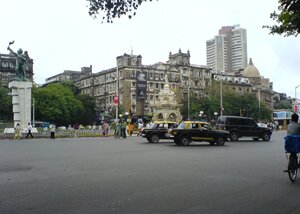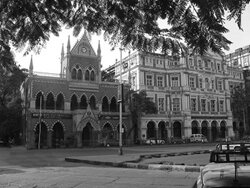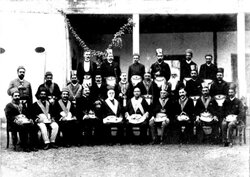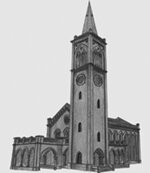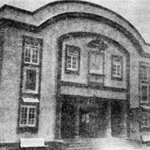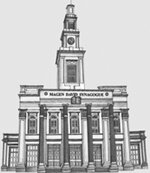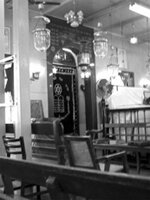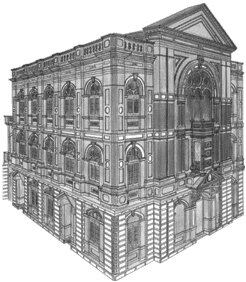| Historic Community of Bombay, India |

|

|
|
Bombay, the capital of the Indian state of Maharashtra, is now known as Mumbai. Modern Mumbai boasts the highest population of any city in India, with approximately fourteen million people residing in this bustling port city. With the surrounding suburbs including the neighbourhoods of Navi Mumbai and Thane, the population tops an impressive 19 million people.
Bombay is also home to the majority of India's rapidly dwindling Jewish population. At its peak, in the late 1940's, the Jewish population of Bombay reached nearly 30,000. The Jews of India lived in harmony with the Indian people and found that the Hindu religion was tolerant of their beliefs and practices allowing them to preserve their own distinct culture for centuries.
The permanent impact though of the Jewish residents, on the permanent landscape of the city, is far greater than its numbers. A walk through Bombay is steeped in Jewish history and Jewish institutions. It is believed that the first Jews settled in Bombay as early as the 6th century, though they were small in number. By the 18th century, Jews began to arrive en-masse to Bombay from the nearby Konkan coast area. The Jews of Bombay were mainly comprised of two very distinct groups, the Bene Israel and the Baghdadi Jews.
The Bene Israel (Sons of Israel) trace their history in the city back over 1600 years ago and their presence in India back to over nearly 2,000 years after a shipwreck stranded seven Jewish families from Judea in a region south of Mumbai. They resided for the most part in the city’s surrounding areas until the British precipitated a boom in development and industry in the city beginning in the 1800’s. Prior to the arrival of the Baghdadi Jews, the Bene Israel who trace their own roots back to the oil pressers in the Galilee, refrained from work on Shabbat, practiced circumcision and respected Jewish dietary laws. The Baghdadi Jews, actually a composite of Jews from Iraq, Syria, Iran and other surrounding areas, settled in the city in the 1800’s. These Baghdadi Jews came to India both to escape religious persecution and in pursuit of the enormous mercantile opportunities that this port city offered. Under British rule, the Jewish community of Bombay flourished. The Baghdadi Jews were well positioned to move between the worlds of East and West and they especially flourished during this time as traders and bankers. They retained their own distinctly Baghdadi identities, spoke Arabic, maintained the traditional Baghdadi style of prayer and deferred to the Baghdad Beit Din. Many later on they came to choose English over Arabic and they often began to don clothing in the style of the English.  The first synagogue was built in Bombay by Samuel Ezekiel Divekar, a Bene Israel. This synagogue Shaare Rahamim or Gates of Mercy, built in 1796, was the first Bene Israel synagogue. While maintaining many Jewish practices, synagogue worship and Jewish texts were not central to their identity. The arrival of the Baghdadi Jews brought Synagogue life to its prominence. The establishment of many other synagogues followed in the region. These include Shaare Rason established in 1840, Tifereth Israel in 1886, Etz Haeem Prayer Hall in 1888, Maghen Hassidim in 1904, Rodef Shalom in 1925 and Kurla Bene Israel Prayer Hall in 1946. Central to Jewish life in Bombay was the The Magen David Synagogue built by David Sassoon in 1861 in Byculla. Byculla was a popular area for the Baghdadi Jews. Later, following further industrial development, many Jews relocated and resided in the Thane area. The Magen David Synagogue was built on beautiful and massive grounds in a style that reflected the finest of Victorian architecture, though the interior was finished in traditional Baghdadi in style. Sassoon also included a Torah school for elementary aged children in the community. The elementary school was later expanded by Jacob Sassoon to include a high school. The grounds themselves were said to have served as the centre for Jewish communal life in Byculla and housed a number of diverse community events as well as daily social interactions.
The rapid merchantile boom in Bombay resulted in an expansion of the city and further development of surrounding suburbs and the fort area as well. Jacob Sassoon, the grandson of David Sassoon, built the Keneseth Eliyahoo Synagogue in the Fort in 1884 near Mahatma Gandhi Road. The synagogue was named in memory of his father Eliyahoo Sassoon. When it was built, this was an elite and fashionable district and a key location for the businesses-minded Jews. Keneseth Eliyahoo Synagogue also housed a number of activities of Jewish communal life and included a mikveh, communal halls and an elementary school. The Jewish population contributed greatly to the industrial and merchanitle growth of Bombay. They were connected to the erection of many secular and philanthrothpic institution in the city including countless hospitals, libraries, schools and monuments. It was the arrival of David Sassoon that truly forever changed the landscape of Bombay. The Sassoon Hospital of Pune and the Clock Tower at Victoria Hospital were built by David Sassoon. A history of the Jews of Bombay more often though reads as a history of the legacy of David Sassoon. This legacy extends far beyond the city of Bombay and into the histories of the Jews of Myanmar, Singapore, Hong Kong and China. David Sassoon, a wealthy Jewish merchant, fled from Baghdad in 1832 along with other Baghdadi Jews. He achieved much success and established the house of David Sassoon & Co., with branches at Calcutta, Shanghai, Canton and Hong Kong and quickly dominated the opium trade making him one of the richest men in India. Â He was not unaware of his ability to impact the life of Jewry in India and he actively pursued his role as a community leader. He was known in the secular world for his leadership as the mayor of Bombay, his business skills and for his extensive philanthropy.
His family’s legacy also includes the Sassoon Hospital Building within the J.J. Hospital Complex in Bombay, the David Sassoon Industrial Institute & Reformatory School, the David Sassoon Library, Comtech House or the Sassoon Head Office, the Gateway of India, the Royal Institute of Science (now the Institute of Science Bombay- right wing), Bombay Flying Club, Nivara Old Age Home which was originally the David Sassoon Elderly & Destitute Persons Home, Flora Fountain, Messina Hospital and Sassoon Docks. In the height of its prominence, the Bombay Jewish community also produced several Jewish newspapers as well as a prolific Jewish publishing industry. Periodicals were regularly produced in Arabic (the original language of the Baghdadi Jews), Hebrew, Marathi and English. A number of Zionist and social organisations were also popular. Tied to the history of the Jews in Bombay is the history of the Jews in Pune, as well, which is located approximately 100 miles south of Bombay. The wealthy Baghdadi Jews of Bombay summered here and also left marks of their tremendous legacy. David Sassoon maintained an impressive residence here and, in fact, died in Pune in 1864. Sassoon’s tomb, an elaborate mausoleum, is located on the grounds of the Red Temple. The Red Temple or Ohel David Synagogue, as it was named, was built in 1863. His former residence still stands across the street. Both structures are importance landmarks in the resort town of Pune. The Synagogue Succath Shelomo is also located in Pune. Beginning in the 1950’s, many of the Baghdadis left India for Israel or for other Westernized countries leaving many of the Bene Israel behind. The Jewish population of Bombay (Mumbai) is but a fraction of its peak in the 1940’s. Many of these residents live in poverty and many struggle against assimilation. The echo of the voices from the days when the sounds of tens of thousands of Jews filled nearly a dozen houses of worship can be still be heard if you listen closely enough. The architectural triumph left behind in the city is a map of their history.  Information and photographs sourced from Nissim Moses. Background and synagogue sketches obtained from www.jacobsassoon.org of the Jacob Sassoon & Allied Trusts. Additionally information and historical photographs from www.jewsofindia.org and www.jewsnindia.com. (Issue March 2008) |



















